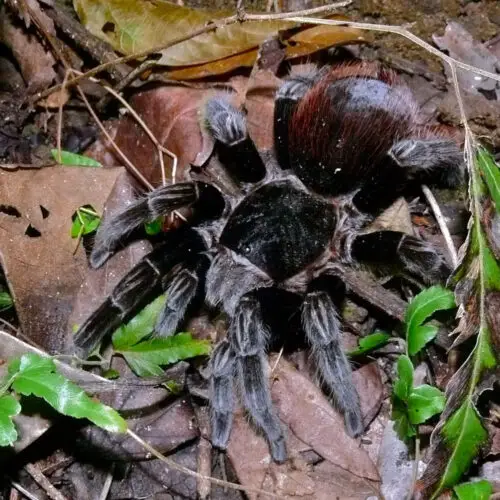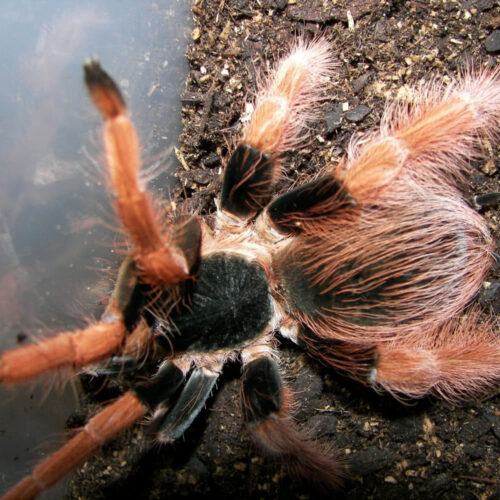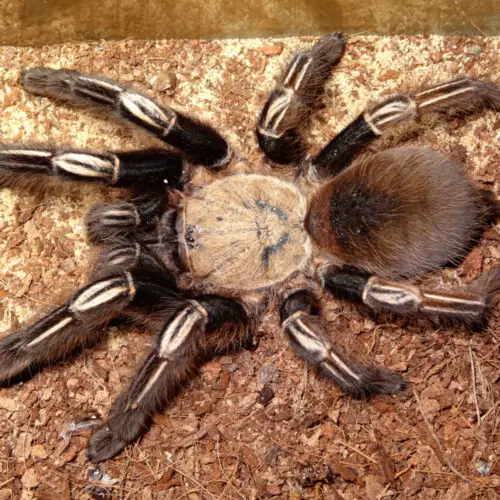If you are looking for a unique, peculiar pet to have – Tailless Whip Scorpion is exactly that.
It belongs to Amblypygi order and is in fact not a scorpion. So far there are 155 specifics species of this order found. Tailless Whip Scorpions are actually arachnids, related more closely to spiders rather than scorpions. They are a mix of spiders, scorpions, and even crabs, all in one. Do not confuse them with Thelyphonida order, which also goes under the same name, but is, in fact, different from each other.
With all that in mind, we could actually call them Tailless Whip Spiders, rather than Whip Scorpions.
If all of that wasn’t enough to entice your curiosity, perhaps some of its characteristics will. Tailless Whip Scorpions come from tropical/subtropical environments, and they can be found worldwide – America, Africa, Asia. They are very much unique looking with their small bodies but enormous legs, and their behavior is very special, given that they’re a combination of spiders, scorpions, and crabs, exhibiting their specific characteristics.
Lifespan & Size
With its different appearance, Tailless Whip Scorpion is usually very small in body size, growing only up to 2 inches. However, their leg span can be as long as 20 inches in size, which makes them very big. Their life spans anywhere between 5 – 15 years, with females living slightly longer than males.
They require several molts before they reach their full size, developing into adults.
Facts & Characteristics
To start off the list of characteristics, we have to talk about the unique appearance of Tailless Whip Scorpion. With their small bodies and large legs, they can actually seem quite intimidating on a first look. But in fact, they are relatively harmless and calm-tempered. They are often darker in color, exhibiting black, grey & brown combinations. During their molting period, they turn entirely white or green, making them very attractive to look at.
Tailless Whip Scorpion has 8 legs in total, 6 of which are used for walking. The other two legs on the front are used as antennas to “feel” the surroundings and to better understand what’s going on in their environment. These legs are very reminiscent of whips, hence the name. Additionally, they do not have a tail attached to their body which makes them different from actual scorpions, also adding up to their name – Tailless Whip Scorpion.
You might be wondering what is their connection to crabs…?
Their movement is what connects them; they move sideways with 6 of their legs – similar to crabs.
Tailless Whip Scorpion is a beginner friendly pet that doesn’t require a lot of special care and attention. Their behavior is somewhat docile, as they are harmless to humans. Feel free to give this very unique spider a chance to be a part of your community. One thing to note is that their bodies are quite fragile, so keep that in mind when taking care of one. Also, their fragility is increased during molting periods, and you must be certain that there are no alive insects in the tank. Otherwise, they might hurt, even kill your spider during its molt.
All Amblypygi species are nocturnal, so they are mostly active during the night. During the day, they will usually hide under some cover, waiting for night time before they take off to hunt down some prey.
Handling & Bite
Due to their body composition, Tailless Whip Scorpions are relatively fragile so handling them may lead to serious injuries. Otherwise, feel free to handle them as you please, just make sure to do so in a slow & calm manner.
Tailless Whip Scorpion does not have a venomous bite.
This spider does not use venom to kill its prey. Instead, it uses pedipals similar to pincers to grab their prey and slowly eat it. Your pet will probably not bite you. However, the “sting” from pincers can be somewhat painful so it’s best to avoid agitating your Tailless Whip Scorpion.
Feeding
Tailless Whip Scorpions are carnivores, so they require meaty foods to thrive. Feeding them is somewhat similar to other arachnid species, after all – they are also called Tailless Whip Spiders.
You should feed them mainly insects that are gut-fed with vegetables.
Here are some food choices:
- Crickets
- Meal Worms
- Wax Worms
- Roaches
They do not require a lot of food due to their small body size. Ideally, you want to feed them two to three times per week, with medium to large sized meals. Always make sure their meals are during night time, as they are nocturnal species. The water dish is not necessary, although it could be useful to keep the humidity levels as necessary.
Care
Taking care of your Tailless Whip Scorpion is a fairly easy task, even if you are a beginner. There are only a couple of things you should be aware of before you decide to host your new pet in your home.
One of these things was already mentioned – Tailless Whip Scorpions are nocturnal species, so most of their activity will be during the night. This also means that they require darker terrariums with less light coming in.
Tank & Habitat
When it comes to their housing, you should follow these general guidelines:
- Tank Size: roughly 10 gallons
- Temperatures of 75 – 80 °F
- Humidity 75% and above
- Substrate: Peat moss, Potting Soil, Coconut Fiber – 2 inch of depth is enough
- Decor: It’s a good idea to provide places to hide, as well as to make terrarium darker
- Air Ventilation is also suggested
This setting work just fine, but you can also experiment with what you like. Just make sure to keep the temperature levels close to that of tropical environments, humidity should always be in the upper levels, and air ventilation is often necessary. Tailless Whip Scorpions can be quite large, so you should give them enough space to move around comfortably. Decorations are nice as they provide shelter so your pet can feel safe, especially during molting periods, this also appeases to their predatory nature so your pet can hunt the prey straight out of its cover.
Breeding
Breeding your Tailless Whip Scorpion is definitely possible, and you don’t have to be an expert to do so.
The only requirement is to have two adults that are ready to mate. Young Whip Scorpions are not capable of breeding, so make sure you wait for several molting seasons to pass before you attempt to breed them. After a certain amount of successful molts, you will notice an extension in your pet’s pedipals as it will be somewhat different looking – this is often a sign of maturity and readiness to breed.
Tailless Whip Scorpion breeding process is closer to scorpions, rather than spiders.
Once you introduce your male & female together, they will signal one another by dancing and tapping each other’s bodies with their whips. Once this happens, the breeding process begins. Unlike spiders, scorpions don’t breed with male depositing his seed inside of a female. Instead, the male scorpion will deposit his spermatophores on the ground that contain his sperm & will then guide the female to pick them up. Female picks up the sperm that will eventually lead to eggs being carried within her abdomen.
Eventually, the eggs will hatch, and mother spider will carry slings on her back until they molt for the very first time. For best results, you should try to keep humidity levels high during the reproduction period.
Images
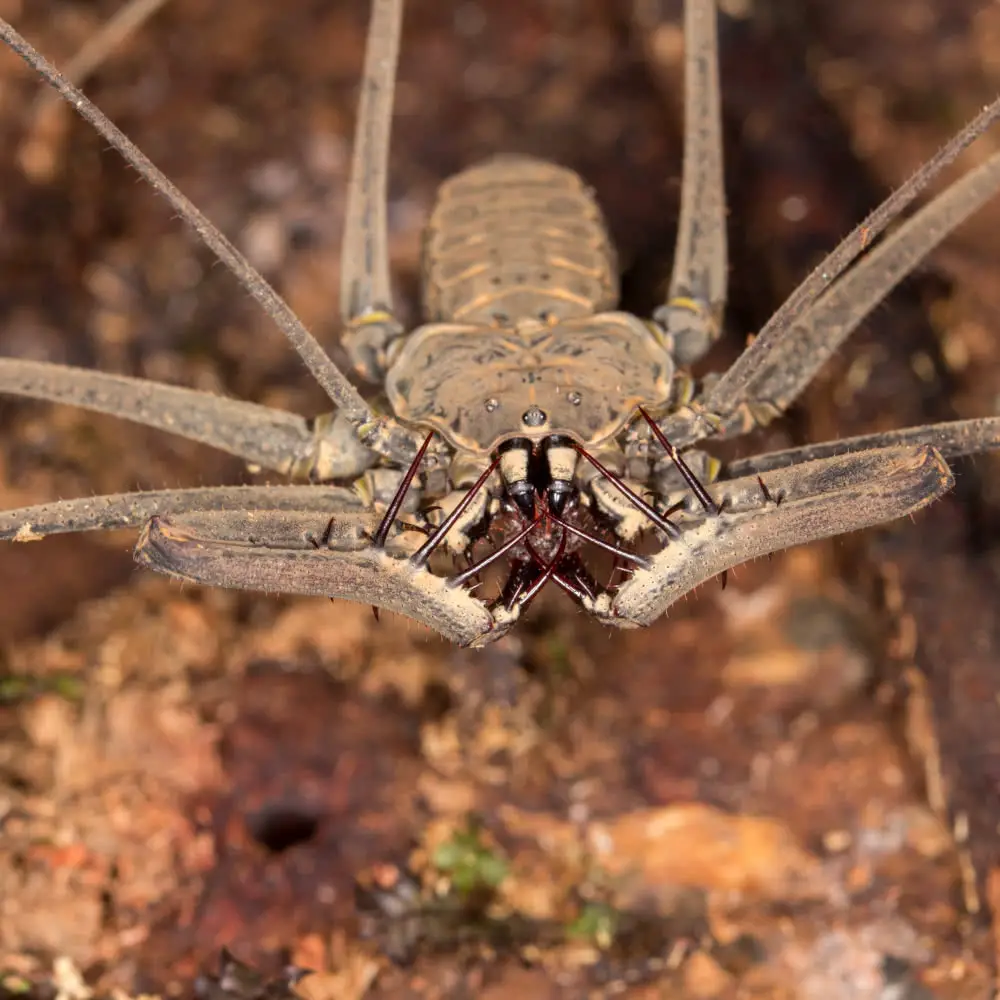
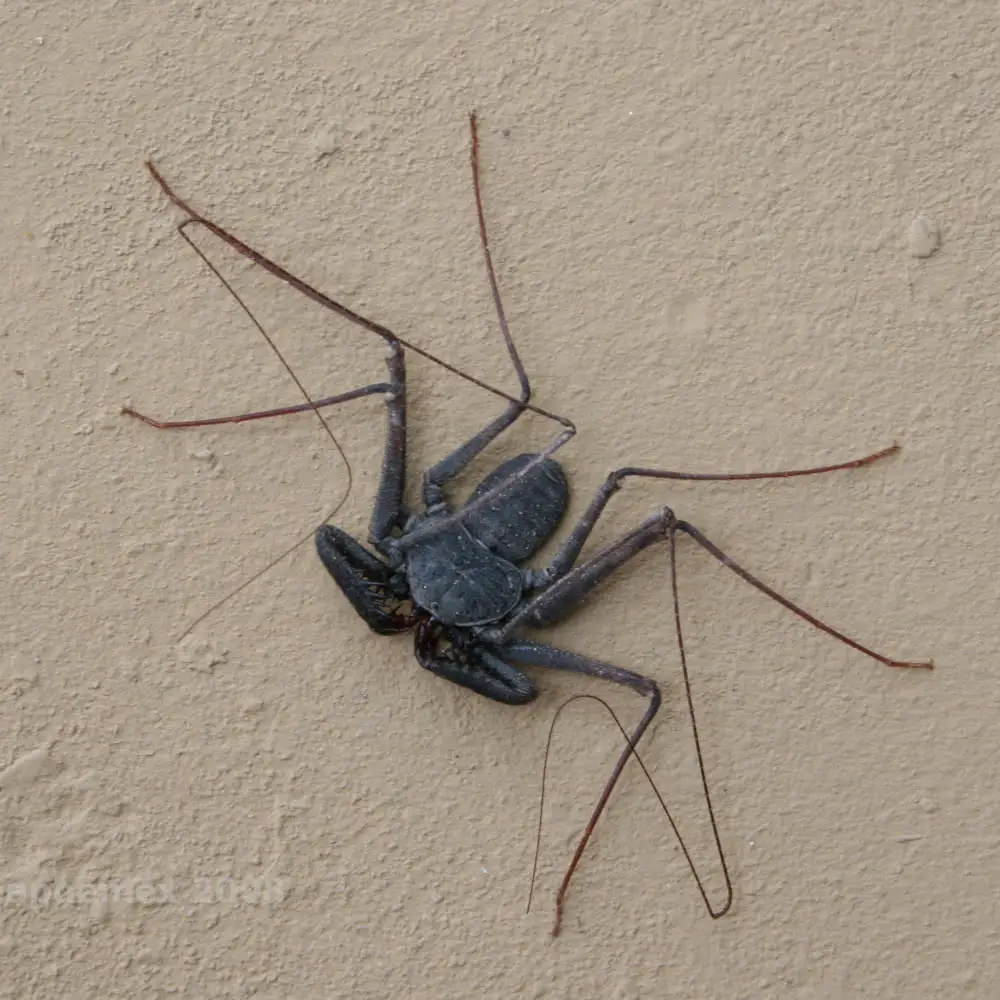
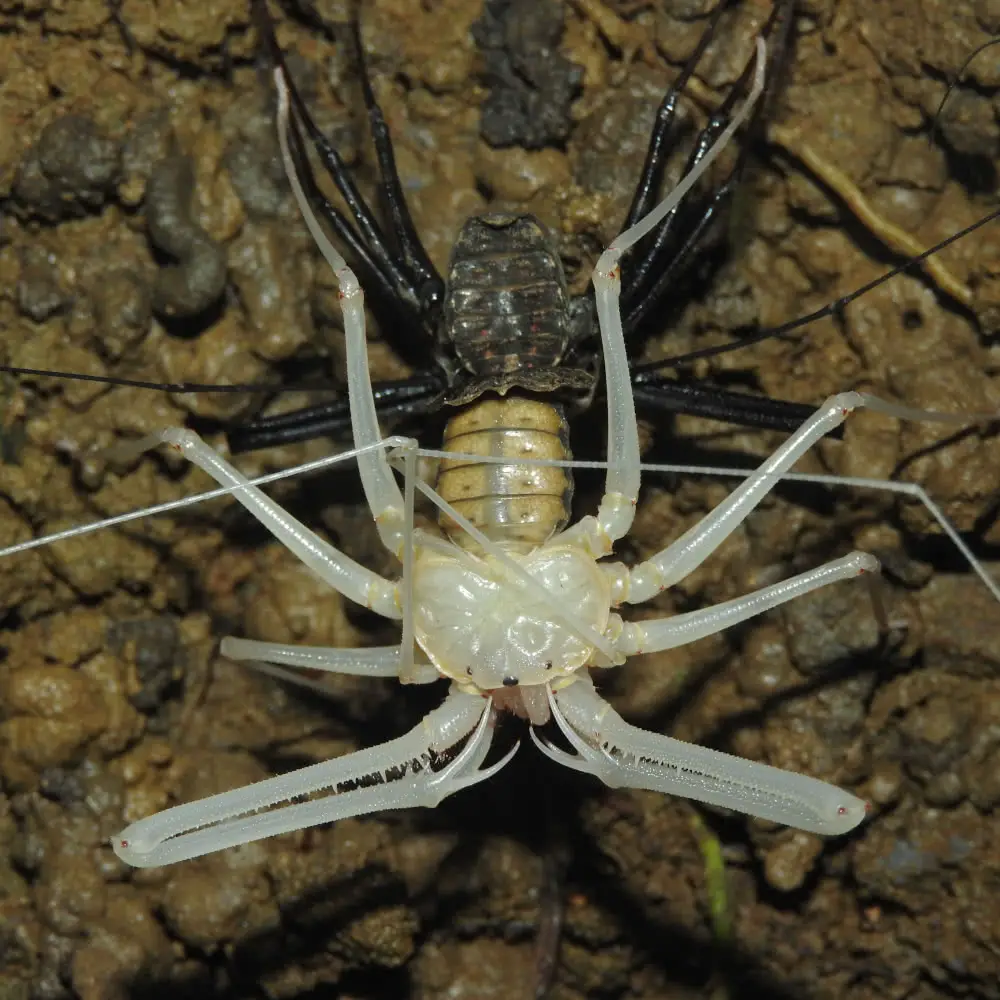
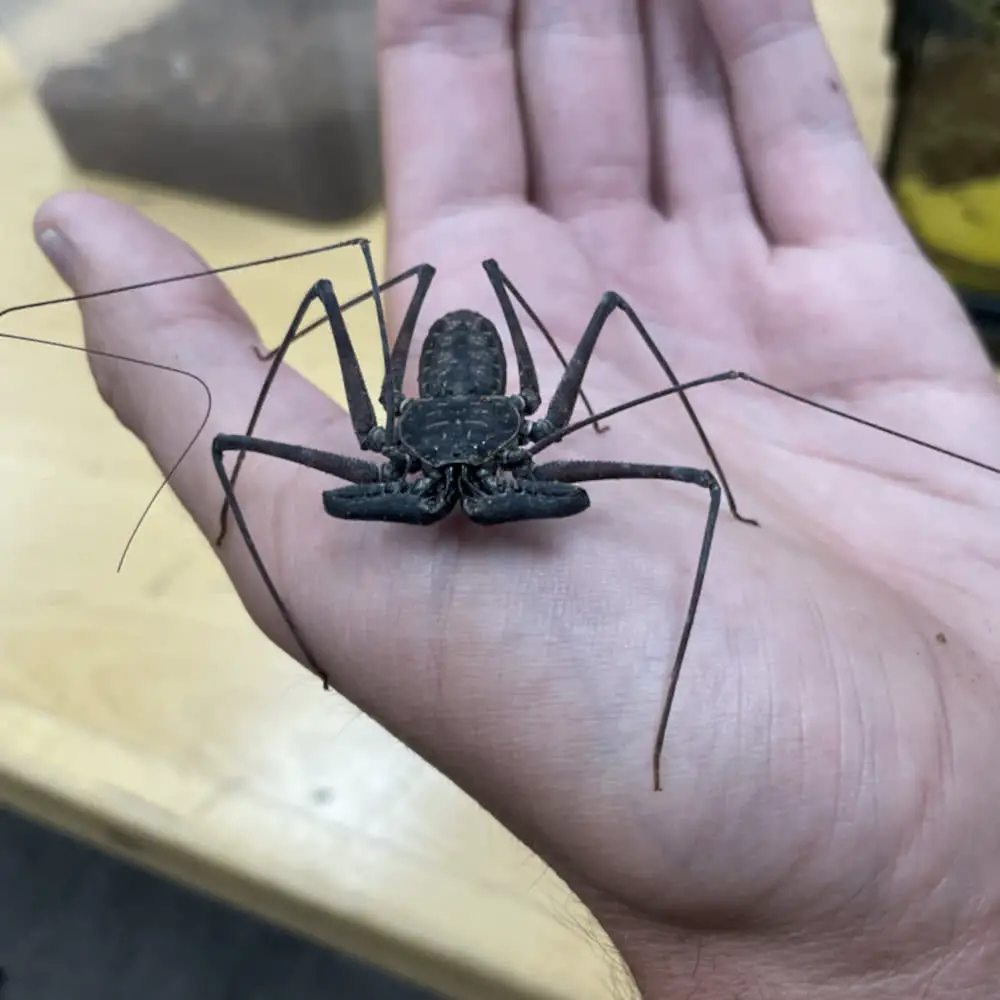
Tailless Whip Scorpion F.A.Q.
What is a tailless whip scorpion?
A tailless whip scorpion, also known as an amblypygid, is a type of arachnid that belongs to the order Amblypygi. Despite its name, it is not a true scorpion and does not possess a stinger or venomous tail. It is characterized by its long, whip-like front legs, which it uses to capture prey and navigate its environment.
How big do tailless whip scorpions get?
The size of tailless whip scorpions can vary depending on the species. On average, they range in size from 2 to 3 inches (5 to 7.5 centimeters) in body length. However, some species can reach up to 8 inches (20 centimeters) in length, including their legs.
Where are tailless whip scorpions found?
Tailless whip scorpions are found in tropical and subtropical regions around the world. They are primarily found in rainforests and other moist habitats, such as caves and leaf litter. They are most abundant in Central and South America, Africa, and Southeast Asia.
Can tailless whip scorpions be found in the United States?
Yes, tailless whip scorpions can be found in the United States, particularly in southern Florida and parts of Texas. They have been introduced to these areas and have established populations.
Are tailless whip scorpions venomous?
Tailless whip scorpions are not considered venomous to humans. While they do possess small pincers that they use to capture prey, they are not capable of injecting venom. Their primary method of defense is their ability to spray a vinegar-like substance from their scent glands, which can be used to deter predators.
Are tailless whip scorpions dangerous to humans?
Tailless whip scorpions are generally not dangerous to humans. They are non-aggressive creatures and will typically try to escape if confronted. While they have large, grasping front legs, they are not capable of inflicting any harmful bite or sting. However, handling them may cause stress and potentially result in injury if mishandled, so it is best to observe them from a safe distance.
What do tailless whip scorpions eat?
Tailless whip scorpions are nocturnal hunters that primarily feed on insects, spiders, and other small arthropods. They are known to be opportunistic feeders and will capture and consume any prey that comes within their reach. Their feeding habits make them beneficial in controlling populations of pests and other unwanted insects.
How do tailless whip scorpions hunt?
Tailless whip scorpions use their elongated front legs, or antenniform legs, to locate and capture prey. These legs are highly sensitive to vibrations and are equipped with slender, spiny structures that help them secure their prey. Once a potential meal is detected, they swiftly seize it with their front legs and use their pedipalps to manipulate and subdue it before feeding.
How long do tailless whip scorpions live?
The lifespan of tailless whip scorpions can vary depending on the species and environmental factors. On average, they live for about 2 to 8 years. Some species have been known to live up to 10 years in captivity when provided with proper care and conditions.
Can tailless whip scorpions survive without water?
Tailless whip scorpions have evolved to thrive in moist environments, and while they can survive for extended periods without direct access to water, they still require some level of humidity to prevent dehydration. They obtain moisture from their surroundings, such as rain, dew, or their prey. However, they are not adapted to live in extremely dry conditions and can suffer from desiccation if not provided with adequate humidity.
Do tailless whip scorpions have predators?
Yes, tailless whip scorpions have predators in their natural habitats. Some of their predators include birds, reptiles, amphibians, and small mammals. In addition, larger invertebrates such as spiders and centipedes may also prey on tailless whip scorpions.
What are the unique features of tailless whip scorpions?
Tailless whip scorpions, also known as amblypygids, have several unique features. They have long, whip-like front legs that they use for sensation and capturing prey. They also have large, pincer-like pedipalps that they use to manipulate food. Tailless whip scorpions have two large, compound eyes that provide them with good vision, and they also possess a pair of antenniform legs that function as sensory organs.
Why are tailless whip scorpions called “whip scorpions”?
Tailless whip scorpions are called “whip scorpions” due to their long, whip-like front legs. These legs, which can be as long as their bodies, resemble whips or antennae. Although they have a scorpion-like appearance, tailless whip scorpions are not true scorpions and do not possess venomous stingers.
Do tailless whip scorpions have a tail?
No, tailless whip scorpions do not have a tail. Despite their name, they lack the long, segmented tail that is characteristic of true scorpions. Instead, they have a long, whip-like pedipalp that serves as a sensory organ.
Are tailless whip scorpions arachnids?
Yes, tailless whip scorpions belong to the arachnid class, which includes spiders, scorpions, ticks, and mites. They share several characteristics with other arachnids, such as having eight legs and a segmented body. However, they have unique features that distinguish them from other arachnids, such as their whip-like front legs.
Can tailless whip scorpions climb walls?
Yes, tailless whip scorpions are highly adept climbers. They have specialized adhesive pads on their legs, which allow them to cling to various surfaces, including walls and ceilings. This climbing ability helps them navigate their natural habitats, such as caves, trees, and rocky crevices.
Do tailless whip scorpions have wings?
No, tailless whip scorpions do not have wings. They are wingless arachnids and rely on their legs for locomotion. However, they are skilled at gliding short distances using their legspan, particularly when they need to move between elevated surfaces.
How do tailless whip scorpions reproduce?
Tailless whip scorpions reproduce sexually. The male deposits a packet of sperm, called a spermatophore, onto the ground or a surface. He then guides the female over the spermatophore, and she picks it up using specialized structures located on her genital operculum. Fertilization occurs internally, and the female later lays eggs, which she carries attached to her abdomen until they hatch into young tailless whip scorpions.
Do tailless whip scorpions make webs?
No, tailless whip scorpions do not make webs like spiders. They are active hunters and primarily rely on their sensory front legs to locate and capture prey. They use their pedipalps to manipulate and tear apart their food items before consuming them.
Can tailless whip scorpions swim?
Tailless whip scorpions are not well-equipped for swimming. While they can survive in areas with moisture or near water, they do not have adaptations for swimming like other arachnids such as water spiders. Instead, they prefer to live in humid habitats and are more agile on land and in climbing situations.
Are tailless whip scorpions active during the day or night?
Tailless whip scorpions are primarily nocturnal creatures, meaning they are most active during the night. They have adapted to be more active during the darker hours, using their well-developed sense of touch, chemoreception, and vibration detection to navigate their surroundings.
Can tailless whip scorpions see in the dark?
Tailless whip scorpions have poor eyesight, especially when it comes to distinguishing detailed images. However, they are not completely blind and can perceive light and darkness. They rely more on their other sensory organs, such as their long whip-like antenniform legs called pedipalps, to navigate and hunt in the dark.
Do tailless whip scorpions have any economic importance?
Tailless whip scorpions do not have significant economic importance. They are not commercially bred on a large scale, and their role in ecosystems primarily revolves around preying on insects and arachnids. However, they can be of interest to entomologists, arachnologists, and enthusiasts who study or keep exotic invertebrates as pets.
How many species of tailless whip scorpions are there?
There are approximately 155 recognized species of tailless whip scorpions, also known as amblypygids or whip spiders. These species can be found in tropical and subtropical regions worldwide, most commonly in Central and South America, Africa, Asia, and Australia. New species are still being discovered and described by scientists.
Can tailless whip scorpions be kept as pets?
Yes, tailless whip scorpions can be kept as pets by experienced arachnid enthusiasts. However, they are not recommended for beginner pet keepers due to their specific requirements and unique behaviors. It’s essential to research and understand their needs before considering them as pets.
Are tailless whip scorpions easy to care for as pets?
Tailless whip scorpions require specific care to thrive as pets. While they have relatively low maintenance needs, they have specific temperature, humidity, and substrate requirements. They also need a suitable enclosure with hiding spots and vertical space to climb. Additionally, feeding them live prey can be challenging, as they prefer small insects such as crickets or roaches.
What kind of enclosure do tailless whip scorpions need as pets?
Tailless whip scorpions require an enclosure that mimics their natural habitat. A glass or plastic terrarium with a secure lid is typically used. The terrarium should have a mix of substrate, such as peat moss or coco fiber, to maintain humidity. It should also include various hiding spots like cork bark or artificial caves, along with branches or other vertical structures they can climb on.
What should I feed my pet tailless whip scorpion?
Pet tailless whip scorpions are primarily insectivores and prefer small live prey. Suitable food options include small crickets, roaches, mealworms, and other appropriately-sized insects. It’s important to provide a varied diet to ensure proper nutrition. The prey should be gut-loaded or fed nutritious food before being offered to the whip scorpion.
Are tailless whip scorpions social creatures?
Tailless whip scorpions are generally solitary creatures and do not exhibit social behaviors like forming colonies or living in groups. In fact, keeping multiple whip scorpions together is not recommended, as they may display aggression towards each other, which can result in injury or death.
Do tailless whip scorpions make any sounds?
No, tailless whip scorpions do not produce sounds as a means of communication or defense. They rely mainly on their sensory organs and physical adaptations to navigate their environment and interact with prey and potential threats.
Can tailless whip scorpions regrow lost limbs?
Yes, tailless whip scorpions can regrow their lost limbs. This process, called regeneration, happens during the molting cycle. It may take several molts to fully restore the lost limb.
Are tailless whip scorpions endangered?
Currently, tailless whip scorpions are not considered endangered or threatened on a global scale. However, like many other creatures, they may face local threats such as habitat loss and pollution.
Can tailless whip scorpions survive extreme temperatures?
Tailless whip scorpions prefer a stable humid and tropical environment with temperatures from 75 to 85 degrees Fahrenheit. They are not capable of surviving under extreme temperatures as they lack the physiological adaptations to endure such conditions.
How do tailless whip scorpions defend themselves?
Tailless whip scorpions utilize their spiny pedipalps for self-defense. These pedipalps are powerful pinchers that are used to immobilize prey or fend off predators. They may also use their long whip-like legs to create vibrations, which can deter predators.
35. Can tailless whip scorpions spray venom like spiders?
No, tailless whip scorpions do not possess venom and cannot spray venom like some spiders do. They are entirely harmless to humans.
Are tailless whip scorpions fast runners?
Yes, tailless whip scorpions can quickly move sideways in their unique crab-like manner, making them fast when they need to escape from predators or catch their prey.
Do tailless whip scorpions have any cultural significance?
Yes, in many cultures, tailless whip scorpions are considered symbols of fear due to their unusual appearance. They have also been featured in movies and television to evoke a sense of horror or mystery.
Can tailless whip scorpions be found in caves?
Yes, tailless whip scorpions can be commonly found in caves, crevices, under rocks, and in leaf litter in various tropical and subtropical regions.
What is the scientific name of the tailless whip scorpion?
The scientific name of the tailless whip scorpion is Amblypygi. This name is derived from the Greek “ambly-/αμβλυ-” meaning “blunt” and “-pygi/pyge/πυγή” meaning “rump”.
Are tailless whip scorpions related to scorpions?
Tailless whip scorpions are not true scorpions, though they are in the same class, Arachnida. They share more characteristics with spiders and are more closely related to this lineage than to true scorpions.
Can tailless whip scorpions take flight?
No, tailless whip scorpions cannot fly. They lack wings and any kind of flight apparatus, so they are terrestrial and remain on the ground.
Are tailless whip scorpions solitary creatures?
Yes, tailless whip scorpions usually lead solitary lives, only seeking company during the mating season. They are also nocturnal creatures that prefer to stay hidden during the day and become active at night.
Do tailless whip scorpions have any medicinal properties?
No, tailless whip scorpions do not have any known medicinal properties. They are not venomous and do not produce substances useful in medical applications.
Can tailless whip scorpions be harmful to plants or crops?
No, tailless whip scorpions are insectivores that primarily feed on small insects and other arthropods. They do not damage plants or crops as they do not consume plant matter.
How do tailless whip scorpions communicate with each other?
Tailless whip scorpions use their sensitive long antenniform legs to perceive their environment and communicate with each other. They also use these legs to send and receive vibrational signals to other whip scorpions, especially during courtship rituals.
Do tailless whip scorpions have any parasites?
Just like any other creature, tailless whip scorpions can potentially be hosts to various forms of parasites. However, there are not many studies or records regarding specific parasites in these creatures.
Can tailless whip scorpions be found in the rainforest?
Yes, tailless whip scorpions are often found in a variety of habitats, including rainforests. They prefer dark, damp environments where they can hide during the day, such as underneath leaves, rocks, or tree bark.
Are tailless whip scorpions territorial?
Not much is known about the territorial behavior of tailless whip scorpions. However, like most nocturnal arachnids, they are generally solitary and avoid confrontations when possible.
Is it possible to find tailless whip scorpions in urban areas?
It is relatively rare to find tailless whip scorpions in densely populated urban areas as they prefer undisturbed habitats like caves, forests, and similar environments. However, they may occasionally be found in quieter suburban gardens or houses.
Can tailless whip scorpions emit any odors?
No, tailless whip scorpions are not known to emit any odors or chemical signals. Their primary means of communication are through physical and vibrational signals.

